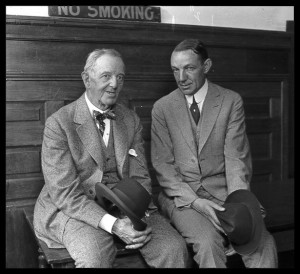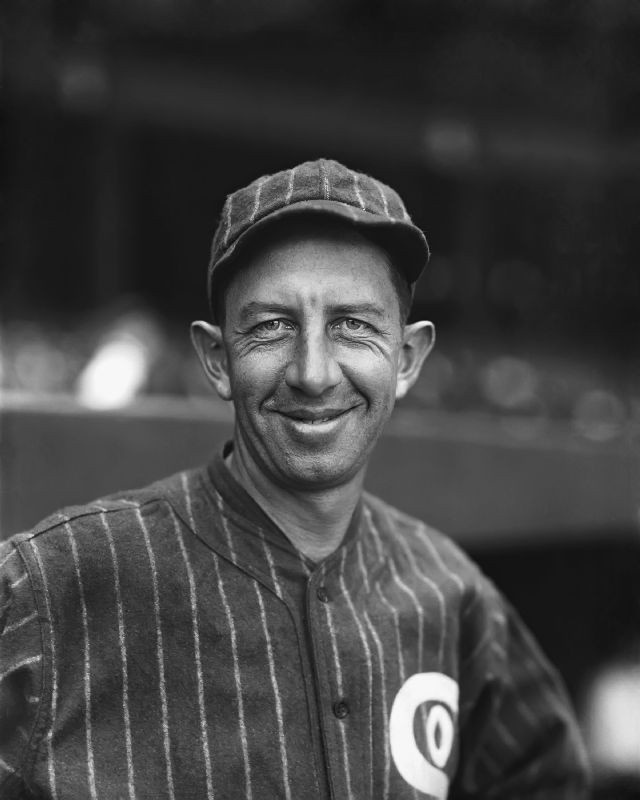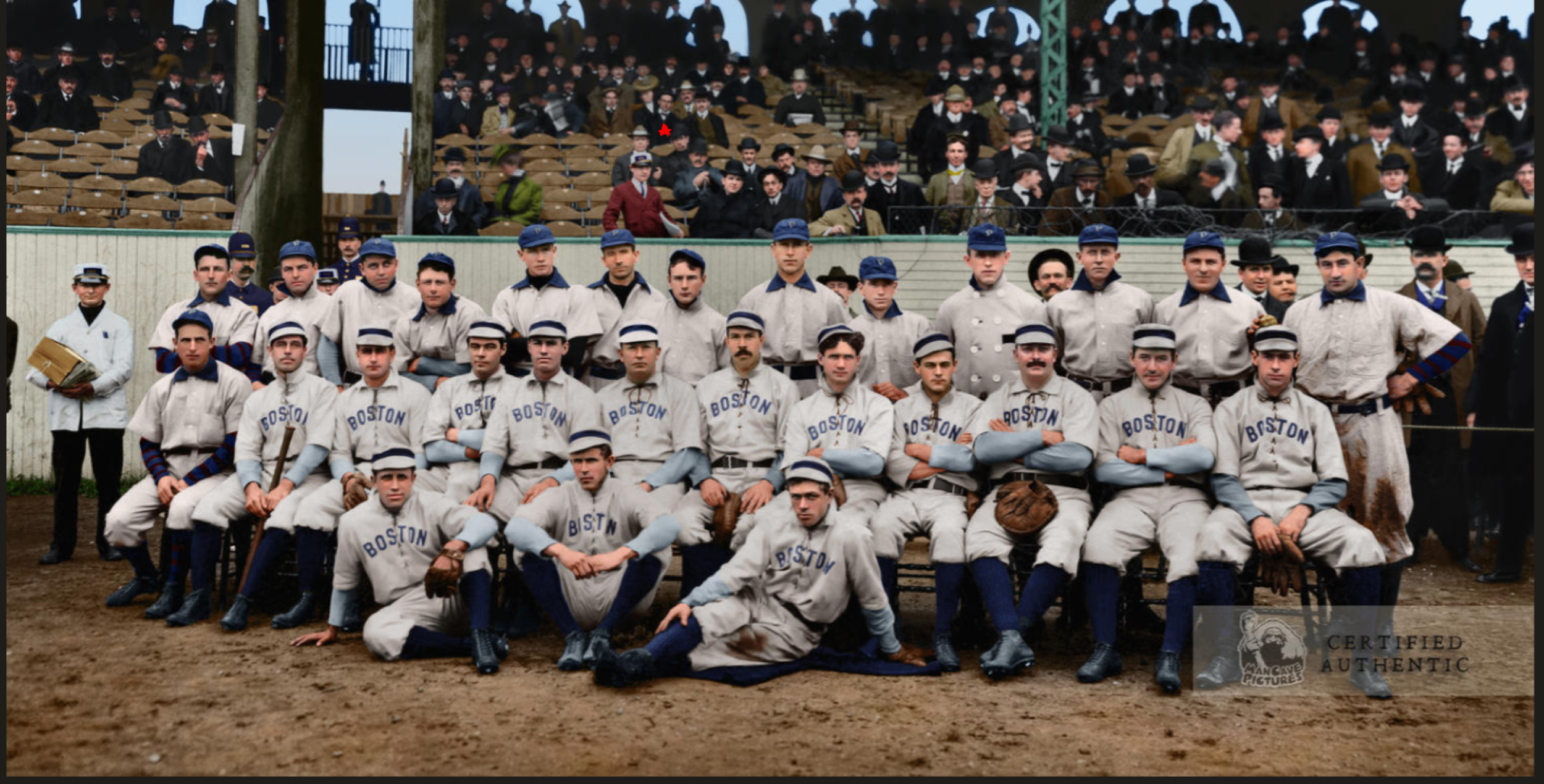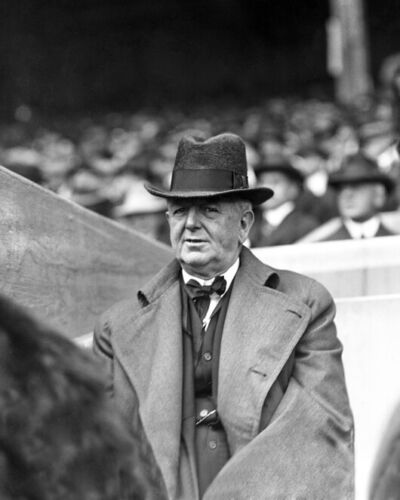Featured Photo Above:
Combined 1903 World Series Photo: Pittsburgh Pirates and Boston Pilgrims
(Color Restoration by Chris Whitehouse of Mancave Pictures)
Baseball History Comes Alive Now Ranked As a Top Five Website by Feedspot Among All Baseball History Websites and Blogs!
(Check out Feedspot's list of the Top 35 Baseball History websites and blogs)

Guest Submissions from Our Readers Always Welcome! Click for details
THE BASEBALL HISTORY COMES ALIVE BLOG
Please note: As we compose new blog entries, we will now send each one out to all our subscribers as we post them. Here’s a link to see the entire Blog Archives -GL
October 4, 2022
Today I’ll continue my weekly “deep dive” into the Black Sox scandal with a look at White Sox owner Charles Comiskey, and address the question: Was the “Old Roman” cheap? Keep in mind that the conventional wisdom tells us that one of the motivating factors for the Black Sox was Commy’s penurious ways. Or was this just another fabrication conceived in the fertile mind of Eliot Asinof? Asinof admitted to Gene Carney that some of the characters and episodes in EMO were fabrications. We just don’t know which ones.
Read this essay and see what you think. It’s a bit long, but if you’re interested in the Black Sox scandal, I think you’ll find it interesting. This essay, along with all the others I’m posting in this series, is a slightly edited version of the one that originally appeared in my 2019 book, Reflections on the 1919 Black Sox: Time To Take Another Look, available on Amazon.
New Blog Topic:
Was Charles Comiskey “Cheap”?
If you ask most knowledgeable baseball fans the question, “Why did eight Black Sox players conspire to ‘fix’ the 1919 World Series?” the answer you would likely hear goes something along these lines: “It was Comiskey’s fault. He was a cheapskate.”
The reason for this response is not hard to uncover. The information most fans have about the 1919 World Series can be traced to Eliot Asinof’s popular 1963 book, Eight Men Out, and the highly successful 1988 movie of the same name written and directed by John Sayles.
The “Comiskey was cheap” meme has been floating around baseball circles since the publication of EMO. It usually has two components: the first, the Old Roman allegedly ordered Eddie Cicotte benched toward the end of the season so that he could not earn a promised $10,000 bonus for winning 30 games; and the second, the White Sox of 1919 were grossly underpaid compared to the other major league teams.

Eddie and the $10,000 Bonus…Was It True?
Let’s take a closer look at these two notions and see if they have validity.
Regarding the bonus, this passage from Eight Men Out is most likely where the story originated:
There were betrayals too. Like Comiskey’s promise to give Cicotte a $10,000 bonus in 1917 if he won thirty games. When the great pitcher threatened to reach that figure, it was said that Comiskey had him benched. The excuse, of course, was to rest him for the World Series.[1]
Did you catch that discrepancy? “…Comiskey’s promise to give Cicotte a $10,000 bonus in 1917…” Did Asinof actually mean 1919? Was this just a typo that got past the editorial staff? In the movie, John Sayles moves the promise to the 1919 season; so the possibility of a typo is real. Anyway, that’s how it appears in the book, so, until further notice, we’ll have to consider the author meant 1917.
In addition, baseball researcher Rob Neyer has wondered where Asinof got this information about a bonus anyway – for either 1917 or 1919 – since there are no footnotes or sources in EMO. Did he just make it up? Neyer asks:
”Asinof’s source for this is unclear, and one begins by wondering how a story of this nature surfaces forty years after the fact.”[2]
One wonders, indeed…
EMO Fabrications…
When author Gene Carney interviewed Eliot Asinof while researching his own book, Burying the Black Sox, he actually got Asinof to admit that some of the stories and characters in EMO were fabrications; and also that many of his sources were, in his words, “amalgams of hundreds of conversation, impossible to document.”[3]
Unfortunately, the problem is that we don’t know which ones are real and which ones are the fabrications. That’s not exactly a ringing endorsement for the reliability of what many consider to be the “definitive book” on the Black Sox scandal.
The record actually shows that in both 1917 and 1919, Eddie had ample chances to win thirty games (he won 28 and 29 respectfully in those two seasons). There is no evidence that Comiskey prevented it from happening.
Let’s consider 1917 first. Gene Carney makes this comment in Burying the Black Sox:
The record shows that Cicotte started thirteen times in August and September 1917, with never more than five days between starts. A few times, he pitched on two days’ rest, and also made four lengthy relief appearances. He had his chances to win thirty, all right, and he led the American League in innings pitched with 347, nineteen more than Walter Johnson.[4]
In addition, baseball researcher Neyer found no mention of a bonus in his search through Chicago Tribune archives. Eddie’s salary since 1915 was $5,000 per season. So a promised bonus of $10,000 in 1917 seems farfetched, and even more unlikely in 1919, when salaries were depressed in the aftermath of World War I.
But what about 1919? After a strong August in which Eddie won four of six starts and two more in relief, Eddie slowed down in September. He won his first two starts and then had a two-week layoff. However, it was Eddie making the claim he had a sore arm, not the White Sox!
Eddie told friends that his arm “…was not lame, but very tired.” But manager Gleason was quoted as saying Eddie’s arm was fine, and he was expecting Eddie to be ready to pitch down the stretch:
“Say, it always was all right and it’s just the same now as it was. Those stories about Eddie having a sore arm were all wrong. He’s ready for the Series.”[5]
The same day, it was Eddie being quoted in the New York Times as saying his arm had been lame a few weeks earlier in September. Again, researcher Bob Hoie has pointed out that this disagreement between Gleason and Cicotte is:
“…exactly the opposite of what one would expect if Cicotte had been artificially held back from winning thirty games in order to cheat him out of a bonus.”[6]
The White Sox management wanted him pitching. Eddie was the one saying his arm was tired. And would the great knuckleballer have been saying this is a bonus of $10,000 was there waiting for him with just one more win? I think he’d be willing to pitch until his arm fell off.
In recent years some hard evidence has turned up about Eddie’s supposed bonus. His “transition card” has been found among 15,000 cards Major League Baseball donated to the National Baseball Hall of Fame in Cooperstown. These cards noted player movement from team to team, and also recorded each player’s salary and other features of their contracts, like bonuses. Eddie’s transition card has no mention of a bonus for winning 30 games in either 1917 or 1919.[7]
So was Eddie benched so as to prevent him from getting a promised $10,000 bonus? There is no evidence to support this, and it has the appearance of an Asinof fabrication.
The Infamous White Sox Payroll…
Many blame Comiskey for his low wages as the motive for the fix. They argue that if the players had been paid fair and decent salaries, they would not have been so willing to risk their careers for a $10,000 payout from the gamblers. But as far as the White Sox 1919 salaries are concerned, we learn this:
Baseball researcher Bob Hoie argues that the 1919 White Sox might have had the top payroll in their league and perhaps in both leagues, around $90,000. In 1920, it was around 113,000. Hoie has been unable to find a team with a higher 1919 payroll.[8]
There’s no doubt that Eddie Cicotte was underpaid in 1919. His salary should have been around $10,000, which is what he was paid in 1920. But the White Sox’ overall payroll was possibly the highest in baseball. Resentment towards Comiskey could have spawned more from the knowledge that Eddie Collins was making $15,000. Was personal jealously a more likely motive?
So was Comiskey “cheap” and did that lead to the Black Sox scandal? Gene Carney comes to this conclusion:
Comiskey’s “Scrooge” image has spread thanks to Eight Men Out, and perhaps to the tendency to read into history assumptions about greedy players or tight-fisted owners. He was probably not exceptionally tight. Every owner wielded the reserve clause as the ultimate closer in contract negotiations. To think of Comiskey as the rule, and not the exception, is hard; but the facts seem to point in that direction. [9]
Comiskey’s well-publicized treatment of the team may also have been a factor in the scheme to toss the Series, e.g., making them pay for their own laundry (or was this just another Asinof fabrication? We have no way of knowing). But it may well be that neither their salaries nor their working conditions were as strong a motive as the allure of making some “easy money” from the gamblers lurking around the sport. If you’re looking for a motive, it might have been as simple as this:

“Here’s our chance to get back at that bastard Commy and his stinking pet, that cocky a**hole Eddie Collins. Here’s our chance to make some real dough…”
As with all things associated with the Black Sox scandal, the notion that Charles Comiskey was “cheap” is one that can be interpreted in different ways. But I for one will not accept EMO as any kind of definite source. I have no vested interest in the story other than a relentless search for the truth.
Charles Comiskey’s Career in Baseball:
Charles Comiskey was a key person in the formation of the American League, and was also the founding owner of the White Sox. He spent 49 years in baseball, as a player, manager, and owner. He broke into the game as a pitcher in 1882 with the St. Louis Browns of the American Association. Due to arm trouble, he shifted to first base and is credited with being the first to play hitters off the bag.
Over his thirteen-year career, he hit .264, with 1530 RBI, 994 runs, and 416 stolen bases. As manager of the Browns from 1883-‘89, he led them to four consecutive pennants (1885-’88), with an overall managerial record of 840-541 (.608). Under his ownership of the White Sox, the team won five pennants and two World Series championships (1906 and 1917).[10]
Charles Comiskey, the Old Roman, passed away on October 26, 1931. Thousands of mourners from around the baseball world attended his funeral. He was inducted into the National Baseball Hall of Fame in 1939.
[1] Burying the Black Sox, p. 195
[2] Ibid, p. 194
[3] Burying the Black Sox, p. 24
[4] Ibid, p. 194
[5] The Chicago Tribune, October 1, 1919
[6] Burying the Black Sox, p. 195
[7] Burying the Black Sox, p. 197
[8] Ibid, p. 194
[9] Ibid, p. 195
[10] Information from Charles Comiskey Wikipedia page
As always, we enjoy reading your comments
Here’s a link to see the entire Blog Archives



Great job as always Gary. I happened to flip on Eight Men Out last night and immediately thought of your series here. While the movie is flawed, theatrical and even overly dramatic at times (the ‘say it ain’t so Joe scene is a bit nauseating), it still is fun to watch the player depictions by the actors and what was going on at the time. I wonder sometimes if the overall player’s avoidance to be a ‘rat’ stopped them from ignoring what happened?
Thanks Mark…it was definitely an entertaining book and movie. As I mentioned in the essay, Gene Carney told me personally that he got Asinof to admit that many of the characters and scenes were fabrications. And as I said, “Not exactly a ringing endorsement for what most people consider to be the definite book on the subject.” In my opinion, a much deeper analysis comes from Carney’s book, Burying the Black Sox, which is heavily sourced and footnoted. As far as being a “rat” is concerned, that’s exactly what Buck Weaver was quoted as saying. He didn’t want to “squeal” on his teammates. And for that he was banned for life along with the others. That was one of the major points of Gene Carney’s book: there were differening levels of involvement..and the punishments should have reflected this.
Thanks Gary for once again putting the events of the 1919 black Sox scandal in perspective. Asimov wrote in the anti establishment era when no corporate act should go unsanctioned.
While the reserve clause is alien to modern sensibilities, I think of Connie Mack – a major high moral character – who had to dismantle great ball clubs just to stay afloat. There certainly were baseball club owners who were less fair with the players in bondage, but not every team was consistently prosperous.
Didn’t Commisky contribute significant dollars to keeping Walter Johnson and other stars not on the White Sox from jumping to the federal league?
Thanks Ed. I agree with all that. Not all owners were saints (with the possible exception of Connie Mack), but neither were the players. Not sure about what you mentioned about Mr. Mack and Walter Johnson, but it certainly has a ring of truth to it.
Hi Gary,
Your “dive” here definitely rates a TEN on this scorer’s card! Congratulations again on another tremendous job. It cannot have been easy.
As any biblical scholar would remind us, the 9th Commandment goes a little something like this: “You shall not give false testimony.” (Heck, your Aunt Tillie probably knows that one by heart.)
Or, as an accumulating storehouse of wisdom from a long line of legal jurisprudence instructs, “A witness who testifies falsely about one matter cannot be trusted to testify truthfully about any matter” — or words to that effect.
So yeah. Mr. Gene Carney back when, and you today, are very right to conduct your challenging archaeological dig into this century-old “scandal” without relying on suspect sources of any kind, particularly AMALGAMS of various anonymous musings pieced together for dramatic effect. Eight Men Out The Window, as far as I’m concerned.
Have you thought about becoming a judge in your next life? Every great one I know has an unerring nose for the truth.
Very best wishes,
Michael
Thanks Michael for the thoughtful comments. As I mentioned, I’m through using EMO as any kind of a definite reference. I really don’t trust anything in there as reliable. Glad you see it the same way. As far as being a “judge” is concerned, my attorney wife has always told me about some of the real “winner” judges she’s encountered over the years…so I’d say that’s out of the question. She’d never allow it! But thanks anyway.
How can The One Who Must Be Obeyed question your judgment???
You married her, didn’t you — ?
M
Haha! I’ll mention that. That and 25 cents might get me a cup of coffee somewhere…not sure where!
Remember, the “factual” book by Al Stump about Ty Cobb was for many years considered to be a historical record of Cobb’s life, especially while he played. Now we know Stump told lies.